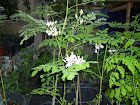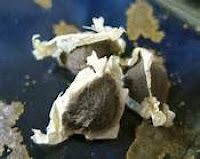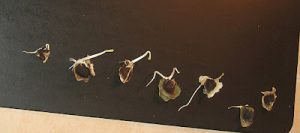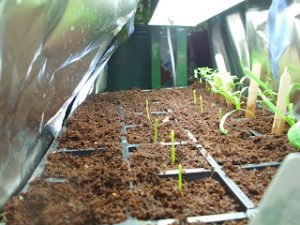Moringa trees with their highly nutritious leaves can be grown at home.
Moringa is one of the few trees that grow very quickly!
Its leaves can be harvested even in the first year or two.
This is not an article for professional large-scale growers.
It is for an individual who just wants to grow several trees.
This article is updated from 2016 when we grew the trees in our business.
You can buy Moringa trees from nurseries in Florida for about $20 to $25.00 or grow them from seeds.
Neem Tree Farms in Florida is where I got my best seed and later several 3-foot trees.
They sell Neem trees as well.
Growing them from seed is both fun and enjoyable especially in Florida and California.
We once had a business doing just that in 2014.

Growing Moringa Questions Answered Below:
How do you tell if your Moringa seed is good quality?
Moringa seeds should be dark brown or black and the hull hard.
If the Moringa Oleifera seed is soft or cream-colored, it is an old seed.
You need to test germinate the Moringa seed you buy if planting in large quantities.

One of the problems in buying seeds is some of the seeds, are old and won’t germinate.
I got some beautiful seeds but none sprouted.
I tried test-germinating them twice with different methods.
I was just out the money for them.
The problem with moringa seeds is the quality of the seed and if it has been irradiated.
They are a tree best suited to grow in Hawaii and Florida.
Any other climate type can be a problem.
If you have any freezing temps, your Moringa trees will not survive those winters.
Even altitude can affect them as well as humidity.
So if your seeds don’t sprout, often it is not the seed but other growing conditions.
They are also subject to mold because of their high protein content.
The seed root tail cannot be broken or they die.
They must be handled and planted gently after they have sprouted.
In the picture below you can see the root on the 1st seed.
Look at the 4th seedling shown from the left, their is a beginning of the tree shoot.
When transplanting any size seedlings, protect the seed root from breaking or the tree dies.
If you let them get too tall, they are very difficult to rehome with the long trunk and the deep root.
Better to transplant them about three feet into like a 33-gal trash can with holes in the bottom.

Again.…..Do not break the fragile roots or the plant will die. Notice the root on the 5th seed over.
The root and the new Moringa shoot come out of the same area of the seed, see the 4th seed over.
Be sure you plant the root down into the soil very gently with the shoot facing upward.
They need to be planted where they can have lots of room for their long tap root.
How many seeds should I germinate?
You need a minimum of three trees for a couple and more for a family.
I would germinate 20 seeds at least to make sure you get enough seedlings for your family.
Some seeds may mold or not germinate.
If you end up with too many baby trees, give them to family or friends as a gift.
It will take them a while for them to get tall and bushy enough to generate enough leaves to eat every day.
What is PKM-1 Seed?
When we were growing Moringa seedlings, we bought PKM-1 seeds and got great results.
Many companies sell PKM-1 seeds.
Always investigate a company before you buy seeds or trees.
Ask if the seed has been irradiated and the age of the offered seeds.
Ask if there is a guarantee when buying the seeds if none of the seeds germinate.
Most of them do not refund your money if the seeds fail to germinate.
The PKM-1 variety of Moringa oleifera seeds is considered by many to be the best.
They were developed at Periyakulam Horticultural College and Research Institute, Tamil Nadu in 1989.
They have been the main seed used by commercial growers since.
These seeds are non-GMO and were developed by selective breeding for 6 generations.
PKM-1 Moringa seeds produce the largest yields of leaves and seed pods in the shortest period.
PKM-1 seed have the same nutritional profile as the leaves and seed pods of standard Moringa Oleifera seeds.
I am not vouching for this site in quoting from their site.
Moringa Seeds: Moringa Oleifera Seeds PKM1 Moringa Trees
The difference between Moringa Oleifera seeds and Moringa Stenopetala?
These are the two most common Moringa species grown commercially.
Moringa Oleifera seeds are brown-colored and winged.
Stenopetala seeds are tan-colored seeds.
Moringa Oleifera Seeds

How should I store Moringa Oleifera Seeds?
Store in a dark, dry, warm area in an air-tight container.
Do not store in the refrigerator or freezer.
These seeds are tropical tree seeds that like warmth.
Moisture will cause them to either sprout or rot.
The best seed is fresh not over a year old.
When should I start my Moringa Seeds? This can be tricky.
Start them indoors in early Spring like you would your tomato seeds.
They need warmth to sprout. If your house is too cold, it will not work.
You can use a seed heat mat or grow lights to get them started indoors.
A warm sunny living room or enclosed porch perhaps.
Do not put them outdoors until it is warm AND the danger of cold weather and frost is past.
One frost will kill them, especially the baby seedlings.
Moringa seeds can be tricky to get started.
If your Moringa seeds do not sprout, they can be stubborn.
Wait until June when it warms up to try again.
If you grow the trees without a heated greenhouse you may find the trees will not grow until summer.
They will just sit there like they are stunted.
I had a whole set this year that did nothing no matter what I tried until June began.
In June they began growing and are doing much better now.
They like very warm, humid weather.
Grow lights and heat mats increase germination.
A heated greenhouse is great but they may go into shock when put out in the real environment.
The Moringa seedlings grow much more slowly without a greenhouse.
It takes the heat to spur rapid growth.
Methods for Germinating Moringa Seeds
#1: Zip Lock Bag Method:
Moringa seeds mold easily because of the high protein they contain.
I would say that is the biggest problem in sprouting the seed.
Pierce the seed hull with your fingernail gently which makes it easier for the seed to sprout.
You can also remove the hull before planting, being careful not to damage the tender seed in the process.
Soak Moringa seeds for several hours in a zip lock bag containing 1/4 cup of warm water.
Next, drain the water from the zip-lock bag.
Lay the bag on a plate so it is flat. Separate the seeds so they don’t touch each other.
Don’t sprout more than 5 seeds in a bag, so they are not crowded.
This will cut down on mold and prevent their shoots from getting entangled as they sprout.
If you see mold growing on the seeds, gently wash the seed hull under warm water.
If you get mold in the bag, move the seeds to a clean bag, to which you have added water, then drained well.
Don’t add additional water to the bag, the seeds are wet enough after being soaked overnight.
Place the plate with the zip lock bag containing the seeds in a warm drawer or in your gas stove.
The temperature should be between 90 and 100 degrees F.
Temperature is important for germination.
Don’t let the seeds get cold.
When the root and stem shoots are about two inches long, transplant them into containers.
Transplant to one-gallon containers with loose, organic potting soil.
Make sure you plant the seed with root shoot down into the soil and stem with the first leaves part up.
Plant in pots from 6 to 9 inches deep.
Do not put the seed portion more than 3/4 inches below the soil surface.
Cake Carrier Container Method

#2: This is how I have spouted my last seeds.
I soak them in water all night. I take my fingernail and pierce the shell.
Then I put a wet paper towel on the plate and put the seeds on the paper towel.
Don’t let the seeds touch each other, then
I put a round glass Corning top over the plate.
I am now using a cake cover that I found at the Dollar Store.
It works the best since the top is high enough not to crowd the seeds.
I waited until the sprout was about two inches in length, then planted them.
If you work, this is not a good method to use.
In the summer heat, the seeds dry out unless sprayed several times during the day.
I am home so I spray the seeds once or twice a day if the paper towel or seeds look dry.
You must be home to use this method and not forget them. I
have the plate on top of my chest freezer in the kitchen.
When doing things in the kitchen, I check on the seeds.
I have had no mold problems with this method.
Direct Peat Pot or Coir Kit Germination Method:
You can use individual pots filled with coir fiber as well. They don’t seem to do well in peat.
Coir fiber is made from coconuts and is a good medium for starting Moringa sprouts.

Set up with a heat mat underneath and grow lights.
The Burpee kit I used this year included a tray with individual cells with a water mat included.
The Burpee Kit is much less work but more expensive.
The mat is reusable. I bought mine at Walmart. They run about $20 to 25.00.
It does not come with a heat mat included.
The seed must be relatively fresh to give good germination results.
Fill the pot to within 1 -1/2 inches or use a peat pot or coir from coconuts.
Lay one soaked Moringa seed on top, then cover loosely with an inch of soil.
Keep soil moist. They germinate in a few days to two weeks.
If you get a kit, you will water it from the bottom.
Each kit comes with a nice water mat.
Utilizing a water mat, you don’t have to worry about the cells drying out or getting too wet.
The plants in their cells sit on top of the water mat.
The mat soaks up water.
The plants soak up water from the mat.
I also used a heat mat under my plants since it is cold in the house.
The heat mat keeps the water and soil warm, so they sprout faster.
They run about 20 to 30 dollars on Amazon. They do help.
If you use individual peat pots, water the soil lightly daily until the shoot becomes visible.
Then add only enough water to keep the soil moist.
They don’t like standing water or soggy soil.
After the shoot is visible, place it in indirect light for a month.
Not all seeds will grow into trees. Some seedlings die out quickly.
Not all seeds are of the same quality.
Growing Moringa Trees From Cuttings
Moringa needs to be planted in soil that drains well.
Sandy loam soil is good.
If you have heavy soil, add peat moss, sand, compost, and aged manure.
I use one from Home Depot called Amend and it is pretty good to add in.
Start with a mature tree. Cut a limb from 1 1/2 feet long and 1 1/2 inches in diameter.
Dry the cutting in the shade for 3 days. Loosen the soil area 2 ‘wide by 2’ deep.
Amend the soil with compost and aged manure.
Plant one-third of the thicker end of the cutting into the ground.
Water the cutting daily until you see green growth buds on the cutting.
Water the cutting when the ground is dry.
Indoors, water the cutting every 2nd or 3rd day after it takes root.
Do not allow water to collect in the tray underneath the potted cutting.
It is generally held that you get faster growth from cuttings.
You harvest 3 times a year. You harvest the leaves, the flowers, and the pods.
The leaves can be harvested all year round in warm climates.
If you are not growing them in the ground, you may not get pods or flowers.
To get pods and flowers you need to grow them in 33-gal trash cans.
Drill plenty of holes in the bottom for drainage.
Cut the tree back when it gets too tall to harvest easily.
It will grow up again quickly and won’t hurt the tree to cut it back.
Protect Your Moringa Seedlings!
You must protect your seedlings with a wire cage.
If you have moles or gophers, you must provide their roots with a wire cage as well.
All animals including cats will eat your seedlings.
You must protect them from chickens, rabbits, goats, mice, squirrels, rats, dogs, and cats.
Eating the Moringa leaves will help your animal’s health but will kill your baby trees.
They will be eaten down to the ground.
I lost some of our seedlings in the house due to that.
Read the next article on the health benefits of eating Moringa leaves Here
I hope you enjoyed this article! Cathryn Freer, the Herbladyisin